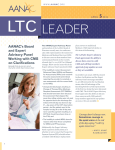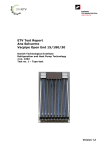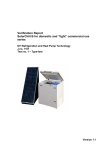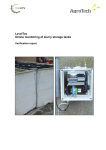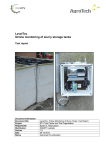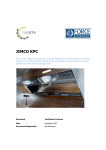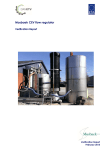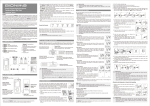Download Specific Verification Protocol Bacterminator Dental
Transcript
Adept Water Technologies A/S BacTerminator® Dental Specific Verification Protocol September 2013 Approved by Morten Rungø (Head of projects, DHI) Peter Fritzel (Verification responsible, DS Certificering) 30-09-2013 X Approved by Signed by: Morten Rungø Adept Water Technologies A/S BacTerminator® Dental Prepared for Adept Water technologies A/S Represented by Michael R. Wick Project No Classification 011987-02 Restricted Authors Mette Tjener Andersson Contents 1 1.1 1.2 1.3 1.4 1.5 2 Introduction ....................................................................................................................................................... 3 Name of technology............................................................................................................................................................. 3 Name and contact of proposer ....................................................................................................................................... 3 Name of verification body/persons responsible for verification ................................................................... 3 Verification organisation, including experts ............................................................................................................ 4 Verification process ............................................................................................................................................................ 5 3 3.1 3.1.1 3.1.2 3.1.3 3.2 3.2.1 3.2.2 3.2.3 3.2.4 3.3 3.4 4 Description of the specific technology for verification ...................................................................... 9 Application and performance parameter definitions ....................................................................................... 10 Matrix/matrices ................................................................................................................................................................. 10 Purpose(s) ............................................................................................................................................................................ 10 Exclusions ............................................................................................................................................................................. 10 Performance parameters for verification .............................................................................................................. 10 Regulatory requirements .............................................................................................................................................. 11 Application based needs ................................................................................................................................................ 12 State of the art performance ........................................................................................................................................ 12 Selected performance parameters ............................................................................................................................ 13 Operational parameters ................................................................................................................................................. 14 Additional parameters .................................................................................................................................................... 14 5 5.1 5.2 5.3 5.4 5.5 Requirements for test design and data quality .................................................................................. 17 Test design ........................................................................................................................................................................... 17 Reference analysis and measurements ................................................................................................................... 18 Data management ............................................................................................................................................................. 18 Quality assurance .............................................................................................................................................................. 18 Test report requirements .............................................................................................................................................. 19 7 Evaluation ......................................................................................................................................................... 21 Calculation of performance parameters ................................................................................................................. 21 Evaluation of test quality ............................................................................................................................................... 21 Additional parameter summary ................................................................................................................................. 22 User manual......................................................................................................................................................................... 22 Required resources .......................................................................................................................................................... 22 Occupational health and environmental impact ................................................................................................. 23 Verification schedule.................................................................................................................................... 25 8 Quality assurance .......................................................................................................................................... 27 9 References ........................................................................................................................................................ 29 6 6.1 6.2 6.3 6.3.1 6.3.2 6.3.3 Overall description of the technology type ............................................................................................ 7 Existing data .................................................................................................................................................... 15 Figures Figure 1-1 Figure 3-1 Figure 3-2 Organisation of the verification and test ............................................................................................................................................ 5 Demo of the BacTerminator® Dental.................................................................................................................................................... 9 Process diagram: 1: DS EN/6117 Approved non-return valve; 2: Head and cartridge for filter/softener; 3 & 4: Solenoid valves; 5: Pressure switch; 6: Optional flow restriction; 7: BacTerminator disinfection chamber; 8: Bio Reaction Zone; 9: Water tank with 20mm air gap; 10: Level sensors; 11: Pump; 12: Pulsation dampener; 13: Leak detector ................................................................................................................................................................ 10 Specific Verification Protocol Bacterminator Dental.docx i Tables Table 1-1 Table 5-1 Table 6-1 Table 6-2 Table 6-3 Table 7-1 Table 8-1 Simplified overview of the verification process ............................................................................................................................. 5 Overview of parameters to be analysed ...........................................................................................................................................18 Criteria for evaluation of user manual ..............................................................................................................................................22 List of capital cost items and operation and maintenance cost items per product unit ...........................................22 Compilation of classified chemicals used during product operation .................................................................................23 Verification schedule .................................................................................................................................................................................25 QA plan for the verification.....................................................................................................................................................................27 Appendices A Terms and definitions Archiving: All standard project files (documents, etc) are archived at DS Certificering. Any other project files (set-up files, forcing data, model output, etc) are archived with the institute performing the tests or analysis. ii Specific Verification Protocol Bacterminator Dental.docx 1 Introduction Environmental technology verification (ETV) is an independent (third party) assessment of the performance of a technology or a product for a specified application under defined conditions and quality assurance. The objective of this verification is to evaluate the performance of the BacTerminator® Dental, a technology based on a combination of filtration and disinfection by electrolysis of water to dental chairs. This verification is performed under the EU ETV Pilot Programme. The verification is performed together with the Chinese ETV Pilot Programme. 1.1 Name of technology BacTerminator® Dental, produced by Adept Water Technologies A/S. 1.2 Name and contact of proposer Adept Water Technologies Diplomvej 378 2800 Kgs. Lyngby Denmark Contact: Michael Reidtz Wick, email: [email protected], phone: +45 8870 8526, mobile: +45 5164 3636 Website: www.adept-dental-water.com 1.3 Name of verification body/persons responsible for verification EU ETV: DS Certificering A/S Kollegievej 6 2920 Charlottenlund Denmark Person responsible for verification: Peter Fritzel (PF), email: [email protected], phone +45 7224 5900 Appointed verification expert: Mette Tjener Andersson (MTA), DANETV, e-mail: [email protected], phone: +45 4516 9148 China ETV: Chinese Society for Environmental Sciences (中 国 环 境 科 学 学 会) No.54 Honglian Nan Cun Haidian District Beijing 100082. P.R.China Specific Verification Protocol Bacterminator Dental.docx 3 Person responsible for verification: Wang Rui (WR) 王睿 (Name in Chinese), email: [email protected], phone: +86 010 62210466. 1.4 Verification organisation, including experts The verification will be conducted by DS Certificering A/S in cooperation with Danish Centre for Verification of Climate and Environmental Technologies, DANETV. The verification is planned and conducted to satisfy the requirements of the ETV scheme established by the European Union (EU ETV Pilot Programme) [1]. The verification will be coordinated and supervised by DS Certification, assisted by an appointed DANETV verification expert. In addition, the verification will be planned and conducted to satisfy the requirement of the Chinese ETV scheme. Therefore this specific verification protocol will be reviewed by China ETV before implementation. Tests will be coordinated and supervised by DHI DANETV test centre with the participation of the proposer, Adept Water Technologies. An internal and an external expert are assigned to provide independent expert review of the planning, conducting and reporting of the verification and tests: • Internal technical experts: o o o • Dr. Gerald Heinicke (GHE), DANETV, e-mail: [email protected] Yi Bin (YB), 易斌 (Name in Chinese), Chinese Society for Environmental Sciences (CSES), email: [email protected] Liu Ping (LP), 刘平 (Name in Chinese), Chinese Society for Environmental Sciences (CSES), email: [email protected] External technical experts: o o Lars D. M. Ottosen (LDMO), Danish Technological Institute, email [email protected] Lin Shaobin (LSB), 林少彬 (Name in Chinese), Chinese Center for Disease Control and Prevention (CDC), email: [email protected] The tasks assigned to each expert are given in more detail in section 8 Quality assurance. The relationships between the organisations related to this verification and test are given in Figure 1-1 . 4 Specific Verification Protocol Bacterminator Dental.docx Figure 1-1 1.5 Organisation of the verification and test Verification process The principles of operation of the DANETV verification process are given in Table 1 1. As it can be seen, verification and testing are divided between the verification body and the test body. Table 1-1 Phase Simplified overview of the verification process Preliminary phase Responsible Document Verification body Quick Scan Testing phase Test body Assessment phase Verification body Contract Specific verification protocol Test plan Test report Verification report Statement of Verification Quality assurance is carried out by an expert group of internal and external technical experts. Two audits of the test system will be performed, starting with an internal audit by the test body followed by an external audit by the DANETV verification body under DS Certification. Reference for the verification process is the EU ETV General Verification Protocol [1] and DS Certificering’s internal procedure [2]. A Statement of Verification will be issued by the DANETV verification body after completion of the verification. The final verification report will include the other documents prepared as appendices. After completion of the verification, an EU Statement of Verification will be issued by the Danish verification body. Based on the verification report and the EU Statement of Verification, a China ETV Statement of Verification will be issued. Specific Verification Protocol Bacterminator Dental.docx 5 6 Specific Verification Protocol Bacterminator Dental.docx 2 Overall description of the technology type The technology behind BacTerminator® Dental is based on on-site generation of disinfectants in an electrolytic cell. Oxidant inactivating the microorganisms is produced from NaCl-salt. The salt can either be salt in the water or added salt. The overall reaction is: NaCl + H2O → NaOCl + H2 Oxidation reactions are carried out at the anode, where two chloride ions (Cl-) are stripped of one electron each to produce chlorine gas: 2Cl- → Cl2 +2e- Depending on the electrolytic cell it is also possible to produce oxidants other than chlorine, which can provide enhanced inactivation of microorganisms. The chlorine gas can react with water and form the strong oxidant “hypochlorous acid” (HOCl): Cl2+ H2O → HOCl + H+ + Cl- The chlorine production is balanced by water reduction reaction taking place at the cathode: 2H2O + 2e- → 2OH- +H2 The hydroxide ions produced then react with the hypochlorous acid (HOCl) producing the oxidant hypochlorite (OCl-): HOCl + OH- → H2O + OCl- Prior to the electrolytic cell units are often installed for filtration and water softening, i.e. removal of CaCO3, to prevent scaling. Hydrogen ventilation may be needed to prevent build-up of hydrogen gas in the system. Specific Verification Protocol Bacterminator Dental.docx 7 8 Specific Verification Protocol Bacterminator Dental.docx 3 Description of the specific technology for verification The description of the technology is based on information from Adept Water Technologies. The BacTerminator® Dental is designed specifically for use in dental clinics and is produced according to ISO 13485 regarding medical devices and is CE-marked as medical device. Figure 3-1 Demo of the BacTerminator® Dental The BacTerminator® Dental includes several water treatment steps to ensure clean water to the dental unit water line: • Pre-filtering - a 100 micron filter stops all major particles • Carbon filter - removes old chlorine and odour from the incoming water • • • • Softening - a ion exchanger removes all scaling from the system to ensure the dental unit will not clog up with scaling Fine filtering - a 1 micron filter removes fine particles Chlorination - an in-line electrolysis produces an adjustable amount of oxidants (chlorine, hypochlorous acid (HOCl) and hypochlorite (OCl-) disinfecting the water Bio Reaction Zone – a chamber ensuring that the bacteria are in contact with the oxidants for a sufficient period of time. Specific Verification Protocol Bacterminator Dental.docx 9 Figure 3-2 3.1 3.1.1 3.1.2 Process diagram: 1: DS EN/6117 Approved non-return valve; 2: Head and cartridge for filter/softener; 3 & 4: Solenoid valves; 5: Pressure switch; 6: Optional flow restriction; 7: BacTerminator disinfection chamber; 8: Bio Reaction Zone; 9: Water tank with 20mm air gap; 10: Level sensors; 11: Pump; 12: Pulsation dampener; 13: Leak detector Application and performance parameter definitions The intended application of the product for verification is defined in terms of the matrix and the purpose. The BacTerminator® Dental is a combination of filtration and disinfection by electrolysis of water to dental chairs. Matrix/matrices The matrix is drinking water to be used in chairs in dental clinics. Purpose(s) The unit is to be used for dental unit water lines or similar applications for the following purposes: • • Prevention of bacteria and other microorganisms in the water. Removal of particles and prevention of scale build up in the water line. The unit has a residual and preventive effect on growth of bacteria and microorganisms in connected subsequent equipment. 3.1.3 Exclusions 3.2 Performance parameters for verification The effect of the technology is only verified under operational conditions as specified by Adept Water Technologies, e.g. in the user manual, and not under any extreme conditions. The performance parameters for the verification comprise parameters that e.g. describe the treated water quality, regulatory requirements, parameters that assess equipment performance 10 Specific Verification Protocol Bacterminator Dental.docx etc. Performance or quality parameters may include chemical, physical and biological parameters. The proposer has specified the performance claims for a BacTerminator® Dental unit as follows: 1. 2. 3. 4. 5. BacTerminator produces a minimum of 0.5 mg/l of free chlorine when the requirements to the concentration of chloride and the conductivity in the incoming water are fulfilled. Removal or inactivation of pathogenic bacteria (Legionella) to undetectable levels (< 1/100 ml), and heterotrophic plate count (HPC, incubated at 37 °C in 48 hours) < 1 CFU/ml in the outlet water of BacTerminator® Dental (i.e. feed to the dental unit). Outgoing water (from the dental unit) has a HPC < 500 CFU /ml and < 100 CFU Legionella/L. No biofilm is generated in new dental chair piping systems. Existing biofilm is removed from old dental chair piping systems. These claims are based on the following operational conditions: • The inlet water shall be of a quality fulfilling WHO’s guidelines for drinking-water quality. • The conductivity is 200-1500μS/cm and the content of chloride is 10-250mg/l in the feed water, according to the unit manual. • Water flow rate out: 1-3L/min @ 2-2½bar. The outlet water flow depends on pump and back pressure. • • 3.2.1 The pH is reduced in the treatment unit by approximately one pH unit in the outlet water. Water flow rate in: 1-1½L/min. The BacTerminator® Dental is restricting this water flow, which otherwise would depend on water tap dimension and water pressure. Regulatory requirements A water cleaning device as the BacTerminator® Dental can be seen as a device for drinking water or as a medical device. Since national regulations for drinking water vary between countries, Adept Water Technologies has chosen to produce the units as medical devices under ISO 13485 Medical devices -- Quality management systems -- Requirements for regulatory purposes and to have their units CE-marked as medical device. A Danish Standard (DS 2451-12) exists on Infection control in the health care sector – Part 12: Requirements for procedures in dental clinics [4]. In the standard, the following criteria are listed with regards to bacteria in the dental chair water: 1. Water in dental units must have a heterotrophic plate count (HPC) < 500 CFU /ml at 37°C. 2. Water from dental units should not contain pathogenic or potentially pathogenic microorganisms. 4. A method must be established to ensure low HPC and minimal occurrence of pathogenic or potentially pathogenic microorganisms. 3. 5. A CFU above 100 CFU Legionella pneumophila/L must not be detected in water from dental units. The water quality, measured as HPC, and the indicator bacteria Legionella pneumophila must be controlled at least every 12 month. Specific Verification Protocol Bacterminator Dental.docx 11 6. 7. Sampling, transport, growing and identification of bacteria must be done by an accredited laboratory. (Note: When sampling, a minimum of 100 ml water is taken from airotor or ultrasonic tooth cleaner.) The dental unit must be secured against back suction. Of main interest with regards to the effect of the BacTerminator® Dental are the criteria 1 to 3. In the US, the criterion is a HPC < 500 CFU/ml, though they recommend a value < 200 CFU/ml. From 1995, manufacturers have been asked to provide equipment with the ability to deliver treated water with < 200 CFU/mL of unfiltered output from waterlines [5]. Other sources also recommend water from dental unit waterlines to contain < 200 CFU/mL [6, 7]. For comparison, the drinking water criteria at the water tap in Denmark are a HPC <200 CFU/ml at 22 °C and 20 CFU/ml at 37°C [8]. The EU criteria for bottled drinking water are 100 CFU/ml at 22 °C and 20 CFU/ml at 37°C [9]. From WHO, there are no specific HPC limit for drinking water. The BacTerminator® Dental produces free chlorine. The chlorine not used for oxidation will stay in the outlet water. In Denmark there is no criterion for free chlorine content in drinking water. It is however specified that the content must be as low as possible, ensuring fulfilment of the microbiological criteria [8]. WHO has set a drinking water guideline value to 5 mg free chlorine/litre [10]. Since water in the dental chair is not used for regular drinking water, the WHO guideline does not have to be fulfilled; a maximum of 50 mg free chlorine/l is seen as relevant for dental chair water. 3.2.2 For disinfection by-products there are several guideline values, for example by WHO, US EPA, and the EU Drinking Water Directive. The US National Primary Drinking Water Regulations state the maximum content levels for Total Trihalomethanes (TTHMs, 80 µg/l) and Haloacetic acids (HAA5, 60 µg/l) as well as for some specific substances [11]. EU has a limit only for total trihalomethanes (TTHMs, 100 µg/l) [9]. Application based needs During chlorination processes there is a possibility of formation of trihalomethanes and other chlorinated by-products, due to the chlorine reacting with organic matter in the water. Adept Water Technologies has included a carbon filter in their BacTerminator® Dental to remove organic matter. A US EPA verification protocol for verification testing for inactivation of microbiological contaminants [12] (with a specific chapter is focusing on on-site generation of halogen disinfectants for inactivation of microbiological contaminants) specifies the water analysis to include the following parameters: general drinking water parameters, free available and total available chlorine, chlorite, chlorate and bromate, disinfection by-products as trihalomethanes and haloacetic acids etc. 3.2.3 The electrode is constructed of metals and heavy metals. It has to be ensured that these are not to be found in concentrations above drinking water quality criteria according to [8]. State of the art performance Competing products TrustwaterTM markets a product, EcasolTM, similar to the BacTerminator® Dental [13]. The technology is based on generation of activated solutions by passing a dilute NaCl-solution through a Flow-through Electrolytic Membrane, segregating the ions formed and producing Ecasol™, a charged disinfectant solution. The positively charged Ecasol™ has a redox value in excess of 600mV, is pH neutral and consists of a mixture of oxidants (mainly hypochlorous acid) in a physically excited state that is capable of penetrating biofilms and is highly microbicidal. In contrast to the BacTerminator® Dental, a salt is added to EcasolTM. 12 Specific Verification Protocol Bacterminator Dental.docx TrustwaterTM has the following claims for EcasolTM: • It is 100 times more effective than Sodium Hypochlorite • It is fully effective against biofilm removal • It is not easily neutralised by organic materials • • • It does not taint the water It is not subject to pH effects It effectively destroys cryptosporidium and other protozoa. TrustwaterTM has performed a test of the EcasolTM at Dublin Dental Hospital’s 103 dental chair units [14]. Mains water of varying quality was treated by specifically selected automated filtration units to provide dental unit chairs with water of a consistent chemical composition. This water was then automatically disinfected using an electrochemically activated solution EcasolTM (2.5 ppm) prior to distribution to chairs. Microbiological quality of the dental unit water line supply and the output water was monitored weekly by culture on R2A agar for 10 sentinel chairs for a 100-weeks period. Dental unit water lines were tested for the presence of biofilm by scanning electron microscopy. The results showed a chemical composition of processed mains water consistently better than potable water standards. Dental unit water line supply water and output water aerobic heterotrophic bacterial counts averaged <1 and 18.1 CFU/mL, respectively, from the 10 chairs compared to 88 CFU/mL for unprocessed mains water. This correlated with the absence of biofilm in the water lines. No adverse effects due to EcasolTM treatment of supply water were observed for water lines or chairs instruments. Blue Safety also manufactures a similar product, though again salt needs to be added [15]. They do not give a detailed list of their claims, but on the homepage the following relevant statements can be found: • • • • 100 times more effective than sodium hypochlorite (NaOCl) An effect is promised after 4-8 weeks after installation (control sample) Effective against pathogen microorganisms (e.g. Legionella and Pseudomonas), virus, algae, fungi and biofilm Safe material and no corrosion, while pH is 7. Other studies and similar products With regards to biofilm reduction a study was performed on 28 dental unit water lines evaluating three disinfection products, based on sodium hypochlorite/citric acid, ethanol/chlorhexidine and hydrogen peroxide/silver ions [16]. After a test period of 8 weeks all three methods showed > 99 % reduction of the baseline (from 1.04-1.45 log CFU/cm2) to below detection limit. 3.2.4 There are many disinfection technologies on the market using electrolysis for generation of chlorine. These are designed for treatment of drinking water, utility water, wastewater and swimming pool water. Some of these claim that their technologies do not form disinfection byproducts [17] such as trihalomethanes. One vendor specifies that the technology is less suitable for Legionella protection [17]. Another vendor specifies that with their technology, a free chlorine concentration of 0.5 ppm is required for protection against Legionella [18]. Selected performance parameters The claims from the proposer are all found to be relevant and valid. In addition to the five claims from the proposer are two claims regarding free chlorine and formed chlorinated by-products. Specific Verification Protocol Bacterminator Dental.docx 13 The selected performance claims for a BacTerminator® Dental unit are: 1. 2. BacTerminator produces a minimum of 0.5 mg/l of free chlorine when the requirements to the concentration of chloride and the conductivity in the incoming water are fulfilled. Removal or killing of pathogenic bacteria (Legionella) to undetectable levels (< 1/100 ml), and heterotrophic plate count (incubated at 37 °C in 48 hours) < 1 CFU/ml in the outlet water of BacTerminator® Dental (ingoing to the dental unit). 3. Outgoing water (from the dental unit) has a heterotrophic plate count < 500 CFU /ml and < 100 CFU Legionella/L. 5. Existing biofilm is removed from old dental chair piping systems. (The test body must specify the level of biofilm acceptable as equal to ”no biofilm growth”). 4. 6. 7. 8. No biofilm is generated in new dental chair piping systems. (The test body must specify the level of biofilm acceptable as equal to ”no biofilm growth”). No formation of halogenated by-products such as trihalomethanes and haloacetic acids. Concentrations are kept below USEPA’s limits for drinking water. Free chlorine content in outlet water of BacTerminator® Dental < 50 mg/L. Level of heavy metals in outlet water is below drinking water quality criteria. These claims are based on the following operational conditions: • The quality of the inlet water must fulfil WHO’s guidelines for drinking-water quality. • Conductivity and chloride must be 200-1500μS/cm and 10-250mg/l (according to the unit manual). • Water out: 1-3L/min @ 2-2½bar. The outlet water flow depends on pump and back pressure. • • 3.3 The pH In the treatment unit is reduced by approximately one pH unit in the outlet water. Water in: 1-1½L/min. The BacTerminator® Dental is restricting this water flow, which otherwise would depend on water tap dimension and water pressure. Operational parameters During operation of the BacTerminator® Dental the following parameters shall be noted: • Water flow (L/min) • Water temperature (°C), pH, hardness (°dH), conductivity (µS/cm), these shall be measured on both sides of BacTerminator® Dental • Power consumption (kWh) The quality of in and out going water shall be analysed for general drinking water parameters. 3.4 Additional parameters Besides the performance parameters obtained by testing, a compilation of parameters describing the ease of understanding the user manual, the required resources, as well as the occupational health and environmental issues of the product were included in the verification. 14 Specific Verification Protocol Bacterminator Dental.docx 4 Existing data No existing test data has been provided by Adept Water Technologies for evaluation under this verification. Specific Verification Protocol Bacterminator Dental.docx 15 16 Specific Verification Protocol Bacterminator Dental.docx 5 Requirements for test design and data quality Based on the application and performance parameters identification the requirements for the test design have been set. A detailed test plan will be prepared separately based on the specification of the test requirements presented below. The test must be planned and performed in accordance with the EU ETV General Verification Protocol [1]. 5.1 Test design Technical specification ISO/TS 11080 Dentistry – Essential characteristics of test methods for evaluation of treatment methods intended to improve or maintain the microbiological quality of dental unit procedural water [19] describes in details how to set up a test of dental chair disinfection technologies such as BacTerminator® Dental. The technical specification evaluates the two following aspects: • • Removal of biofilm from surfaces within the dental unit water delivery system Prevention or inhibition of biofilm formation on surfaces within the dental unit water delivery system. The detailed test design, to be described in a test plan from DHI, must therefore be based on ISO/TS 11080. ISO/TS 11080 only focuses on HPC, while for this verification also Legionella must be included, due to the selected performance parameters. According to ISO/TS 11080 it is possible to use either tap water or a challenge suspension. Due to health risks when handling Legionella it is preferred to use tap water containing Legionella. This is done by identifying a hot water source with Legionella and by using this source for contamination of DHI tap water. The biofilm in the tubing system is created by leaving the surrogate chair at room temperature and in periods leaving the water stagnant in the tubes. The biofilm creation can be measured indicative by measuring CFU-level in the outlet water. ISO/TS 11080 specifies a HPC range in the dental chair system of 104-106 CFU/ml when testing removal of biofilm. Due to the decision of using tap water as bacteria source it can be difficult to reach a sufficiently high CFU-level. After measurement of CFU-level, the test body must consult the verification body and Adept Water Technologies to decide whether microbial suspension is needed and how it can be done with minimum risk. The actual biofilm on tube surface must, in addition to the CFU in water indicator, be measured before start of testing. It is anticipated that 3-4 samples are needed during establishment of the biofilm in the dental chair and the same number of samples shall be taken to follow the removal of biofilm. According to ISO/TS 11080 the test can be performed in an actual dental chair or in a surrogate chair. For this verification test surrogate dental chairs will be constructed and placed in a laboratory. The microbiological testing will be performed as agar plate culturing of water sampled in colony forming units (CFU) per millilitre. In addition to the requirements of ISO/TS 11080, Legionella analyses must be performed. Adept Water Technologies have claimed that the BacTerminator® Dental ensures no biofilm formation in new dental chairs and removal of biofilm in current dental chairs. Therefore the test needs to include test on a newly built surrogate dental chair with no biofilm, and on a surrogate dental chair with pre-grown biofilm. Specific Verification Protocol Bacterminator Dental.docx 17 5.2 Reference analysis and measurements As reference analyse to the agar plate culturing, samples of the tube for the surrogate dental chair must be analysed for assessing biofilm on the surface. Table 5-1 gives an overview of the required parameters to be analysed during the test. Table 5-1 Parameter Overview of parameters to be analysed Analyse method / device Legionella source Bacteria in water phase HPC 36, HPC R2A X Bacteria on surface (biofilm) HPC R2A, Direct microscopic count Legionella 5.3 X Output water from BacTerminator® Dental X Outgoing water from dental unit Tube sample from dental unit X X Free chlorine Plate count Hach Lange photometric equipment, chlorine sticks X Temperature, pH, hardness, conductivity Drinking water parameters1 Trihalomethanes, haloacetic acids Heavy metals (determined by the composition of the electrode material) Regular online devises Regular methods X GM-MS Water source X X X X X X X X X X ICP-MS X Data management Data storage, transfer and control must be in accordance with the requirements of the DHI DANETV test centre quality manual [20], enabling full control and retrieval of documents and records. The filing and archiving requirements of the DHI quality manual must be followed; i.e. 10 years archiving. The actual data handling must be specified further in the test plan. 5.4 Quality assurance The quality assurance of the tests must include 1) control of the test system (in this case the setup with BacTerminator® Dental and surrogate dental chair), 2) the on-line measurement equipment (performance evaluation audit), 3) control of analysis performed at external laboratory (results from proficiency tests) and 4) control of the data quality and integrity. The test plan and the test report will be subject to review by an internal expert. Furthermore, the test plan and test report must be subject to review by the person responsible for the verification (in this case both DANETV and China ETV) and Adept Water Technologies. The test plan must be approved by the verification bodies and Adept Water Technologies prior to initiating tests. 1 18 E.g. according to Normal control at the laboratory Eurofins: www.eurofins.dk/media/3224791/drikkevandspakker_2013.pdf Specific Verification Protocol Bacterminator Dental.docx A test system audit will be performed during the verification testing by a certified auditor from the DANETV verification body. All analyses must be performed under ISO 17025 accreditation. If this is not the case, detailed explanation for the deviation must be given. 5.5 Test report requirements The test data provided in the test report must follow the principles of template of the DHI DANETV test centre quality manual [20], with data and records from the tests presented. Specific Verification Protocol Bacterminator Dental.docx 19 20 Specific Verification Protocol Bacterminator Dental.docx 6 Evaluation 6.1 Calculation of performance parameters Bacteria For the parameters bacteria (heterotrophic plate count), Legionella and biofilm graphs must be drawn. The following parameters must be identified: • Biofilm development in new chair with BacTerminator® Dental • Biofilm in chair without BacTerminator® Dental – control measurement • Level of heterotrophic plate count without BacTerminator® Dental – control measurement • Level of Legionella without BacTerminator® Dental – control measurement • • • • • • • Biofilm in old chair after installation of BacTerminator® Dental Level of heterotrophic plate count after BacTerminator® Dental Level of Legionella after BacTerminator® Dental Level of heterotrophic plate count after surrogate dental chair with BacTerminator® Dental Level of heterotrophic plate count after surrogate dental chair without BacTerminator® Dental – control measurement Level of Legionella after surrogate dental chair with BacTerminator® Dental. Level of Legionella after surrogate dental chair without BacTerminator® Dental – control measurement These levels from chairs with BacTerminator® Dental must be compared to values from the control measurements. Free chlorine The average and standard deviation of measurements for free chlorine must be determined at: • • The sampling point just after the BacTerminator® Dental The sampling point after the surrogate dental chair. Contact time (in mg free Cl2 * min) is calculated based on water flow and free chlorine concentration. Plot relation between contact time and bacterial (heterotrophic plate count and Legionella) reduction. Chlorinated by-products The average and standard deviation of measurements for chlorinated by-products as trihalomethanes and haloacetic acids must be determined at: • 6.2 The sampling point after the surrogate dental chair. Evaluation of test quality The test data provided in the test report will be evaluated against the requirements set in this protocol and the objectives set in the test plan. Focus will be specifically on the planned 1) control of the test system, 2) performance evaluation audit (e.g. for online measurements), 3) con- Specific Verification Protocol Bacterminator Dental.docx 21 trol of analysis performed at external laboratory (results from proficiency tests) and 4) control of the data quality and integrity. Spread sheets used for the calculations will be subject to control on a sample basis (spot validation of at least 5% of the data). 6.3 Additional parameter summary 6.3.1 User manual The verification criterion for the user manual is that the manual describes the use of the equipment adequately and is understandable for the typical test coordinator and test technician. This criterion is assessed through evaluation of a number of specific points of importance, see Table 6-1 for the parameters to be included. A description is complete if all essential steps are described, if they are illustrated by a figure or a photo, where relevant, and if the descriptions are understandable without reference to other guidance. Table 6-1 Parameter Criteria for evaluation of user manual Complete description Summary description No description Not relevant Product Principle of operation Intended use Performance expected Limitations Preparations Unpacking Transport Assembling Installation Function test Operation Steps of operation Points of caution Accessories Maintenance Trouble shooting 6.3.2 Safety Chemicals Power Required resources The capital investment and the resources for operation and maintenance could be seen as the sustainability of the product and will be itemized based on a determined design [21], see Table 6-2 for the items that will be included. Table 6-2 Item type List of capital cost items and operation and maintenance cost items per product unit Item Number None Capital Site preparation Buildings and land 22 Specific Verification Protocol Bacterminator Dental.docx Item type Equipment Utility connections Installation Start up/training Permits Item Number None Operation and maintenance Materials, including chemicals Utilities, including water and energy Labor Waste management Permit compliance The design basis will be described and the cost items relevant for the BacTerminator® Dental will be listed. Note that the actual cost for each item is not compiled and reported. Evaluation will also be done on the following subjects: • Resources used during production of the equipment in the BacTerminator® Dental • Robustness/vulnerability to changing conditions of use or maintenance • • • 6.3.3 Longevity of the equipment Reusability, recyclability (fully or in part) End of life decommissioning and disposal. Information on these subjects will be obtained from Adept Water Technologies and from the test body’s experiences with the BacTerminator® Dental during the planned tests. Occupational health and environmental impact The risks for occupational health and for the environment associated with the use of the products will be identified. A list of chemicals classified as toxic (T) or very toxic (Tx) for human health and/or environmentally hazardous (N) (in accordance with the directive on classification of dangerous substances [22]) will be compiled. The information will be given as amount used per product unit (sample), see Table 6-3 for format. Table 6-3 Compilation of classified chemicals used during product operation Compound CAS number Classification Amount used per product unit Additional risks from installing, operating and maintaining the product will be evaluated, compiled and reported, if relevant. In particular, risks for human health associated with power supply and danger of infections will be considered. Specific Verification Protocol Bacterminator Dental.docx 23 24 Specific Verification Protocol Bacterminator Dental.docx 7 Verification schedule The verification is initiated in the summer of 2013. A detailed schedule is given in Table 7-1. The time schedule should be seen as tentative, especially since the time required for formation of biofilm in the surrogate dental chair is unknown. Table 7-1 Task Verification schedule Specific verification protocol Verification Body DANETV July 2013 Aug 2013 Testing, incl. test planning, testing and reporting Oct 2013- Feb 2014 Review of test plan Oct 2013 Test system audit ̴ Dec 2013 Assessment and verification reporting Issuing of Statement of Verification Specific Verification Protocol Bacterminator Dental.docx Oct 2013 March 2014 Review of test report and verification report Handle external and proposer’s review of verification report Test Body June 2013 Review of specific verification protocol Handle external + proposer review of specific verification protocol Verification Body China ETV April 2014 April-May 2014 May 2014 June 2014 25 26 Specific Verification Protocol Bacterminator Dental.docx 8 Quality assurance The staff and the experts responsible for quality assurance as well as the different quality assurance tasks can be seen in Table 8-1. All relevant reviews will be prepared using the DANETV review report template [20]. An audit of the test will be performed by the DANETV verification body. Table 8-1 QA plan for the verification Initials Tasks Specific verification protocol Test plan Test system at test site Test report Verification report Statement of Verification Internal expert GHE Review Review Verification body DANETV MTA PF Review Approve Audit Review Verification body China ETV + external expert Proposer External expert Review Adept Review LDMO Review Review Review Review Review + approve Review audit report Review Review Review + approve Acceptance Review Internal review is conducted by Gerald Heinicke (GHE) from DANETV and a test system audit is conducted following general audit procedures by certified auditor Peter Fritzel (PF) from DS Certificering. The verification protocol and the verification report require external review according to EU ETV pilot programme GVP [1]. External review will be performed by Lars D. M. Ottosen (LDMO), Danish Technological Institute. The verification body will review and approve the test plan and review the test report. The review will be performed by Mette Tjener Andersson (MTA), while the approval will be given by Peter Fritzel (PF). China ETV and their external expert, Lin Shaobin (LSB), Chinese Center for Disease Control and Prevention, will review the documents and will also approve the test plan before start of testing. Specific Verification Protocol Bacterminator Dental.docx 27 28 Specific Verification Protocol Bacterminator Dental.docx 9 References 1. 2. 3. 4. 5. 6. 7. 8. 9. 10. 11. 12. 13. 14. 15. 16. 17. 18. 19. 20. 21. 22. EU Environmental Technology Verification pilot programme. General Verification Protocol. 15-12-2011. DS Certificering. ETV – Verifikation. I30.11, Environmental Technology Verification. ISO Medical devices -- Quality management systems -- Requirements for regulatory purposes. ISO 13485:2003. Dansk Standard. Infection control in the health care sector- Part 12: Requirements for procedure in dental clinics. DS 2451-12. 2nd edition. 2012-11-27. Department of Health and Human Services, Centers for Disease Control and Prevention. Morbidity and Mortality Weekly Report. Guidelings for Infectio Control in Dental Healthcare Settings. Vol. 52, No. RR-17. 19.12.2003 Australian Dental Association Inc. ADA Guideline for Infection Control. Second edition. 2012. Tandlægebladet. Ny undersøgelse: Mange desinfektionsanlæg virker ikke. 09.12.2008. Bekendtgørelse om vandkvalitet og tilsyn med vandforsyning. BEK No. 1024. 31.10.2011 EU. Council Directive 98/83/EC of 3 November 1998 on the quality of water intended for human consumption (EU Drinking Water Directive). WHO. Chlorine in Drinking-water. Background document for development of WHO Guidelines for Drinking-water Quality. WHO/SDE/WSH/03.04/45. 2nd edition, vol. 2. 2003. USEPA National Primary Drinking Water Regulations, List of Contaminants and their (MCLs). http://water.epa.gov/drink/contaminants/index.cfm. Located 2013.07.03 US EPA and NSF International. Protocol for equipment verification testing for inactivation of microbiological contaminant. 2003. Located on www.epa.gov/etv/pubs/039204epadwctr.pdf, 27-06-2013. TrustwaterTM. Information on EcasolTM. Located at www.trustwater.com/markets/dental/ at 26-06-2013. O’Donnell MJ, Boyle M, Swan J, Russell RJ, Coleman DC. A centralised, automated dental hospital water quality and biofilm management system using neutral Ecasol maintains dental unit waterline output at better than potable quality: a 2-year longitudinal study. Journal of Dentistry 2009, 37(10):748-762. Blue Safety. Information on dental products. Located at www.bluesafety.com at 28-062013. A. J. Schel, P. D. Marsh, D. J. Bradshaw, M. Finney, M. R. Fulford, E. Frandsen, E. Østergaard, J. M. ten Cate, W. R. Moorer, A. Mavridou, J. J. Kamma, G. Mandilara,6 L. Stösser, S. Kneist, R. Araujo, N. Contreras, P. Goroncy-Bermes, D. O'Mullane, F. Burke, P. O'Reilly, G. Hourigan, M. O'Sullivan, R. Holman and J. T.Walker. Comparison of the Efficacies of Disinfectants To Control Microbial Contamination in Dental Unit Water Systems in General Dental Practices across the European Union. Appl Environ Microbiol.72(2), p. 1380–1387. February 2006. Grundfos Disinfection. Effective Disinfection For Healty Water Rev 03/10. Located on www.cff3.com/sqlimages/colormark/LocalUser/grundfos/PDFS/loResPDFArt/lddsl15lr. pdf, 26-06-2013. Danish Clean Water. Technical Brochure. 2009. Located on www.danishcleanwater.dk/enGB/Technology/Download-informations.aspx, 27-06-2013. ISO. Technical specification ISO/TS 11080 Dentistry – Essential characteristics of test methods for evaluation of treatment methods intended to improve or maintain the microbiological quality of dental unit procedural water. First edition. 01-06-2009. DHI DANETV test centre quality manual. Version date 21.03.2013. Gavaskar, A. and Cumming, L.: Cost Evaluation Strategies for Technologies Tested under the Environmental Technology Verification Program. 2001. Battelle. European Commission: Commission Directive on classification, packaging and labelling of dangerous substances. 2001/59/EC. 2001. Specific Verification Protocol Bacterminator Dental.docx 29 30 Specific Verification Protocol Bacterminator Dental.docx A P P E N D I C E S Specific Verification Protocol Bacterminator Dental.docx 1 Specific Verification Protocol Bacterminator Dental.docx A P P E N D I X A Terms and definitions Specific Verification Protocol Bacterminator Dental.docx Specific Verification Protocol Bacterminator Dental.docx The terms and definitions used by the verification body are derived from the EU ETV GVP, ISO 9001 and ISO 17020. Term DANETV Comments on the DANETV approach Accreditation Meaning as assigned to it by Regulation (EC) No 765/2008. EC No 765/2008 is on setting out the require- Additional parameter Other effects that will be described but are considered secondary. None Amendment Application Is a change to a specific verification protocol or None The use of a product specified with respect to The application must be defined with a preci- a test plan done before the verification or test step is performed. matrix, purpose (target and effect) and limitations. CFU Colony forming unit. DANETV Danish centre for verification of environmental technologies. GC-MS Deviation Evaluation Experts General verification protocol (GVP) HPC HPC 36 ments for accreditation and market surveillance relating to the marketing of products. Gas chromatography mass spectrometry sion that allows the user of a product verification to judge whether his needs are comparable to the verification conditions. None Is a change to a specific verification protocol or None Evaluation of test data for a technology product for performance and data quality. None a test plan done during the verification or test step performance. Independent persons qualified on a technology in verification. These experts may be technical experts, QA Description of the principles and general pro- None cedure to be followed by the EU ETV pilot programme when verifying an individual environmental technology. experts for other ETV systems or regulatory experts. Heterotrophic plate count. Heterotrophic plate count according to ISO 6222 Water quality - Enumeration of culturable micro-organisms - Colony count by inoculation in a nutrient agar culture medium. The agar is yeast extract agar, pour plate inoculation (mixed with fluid agar) and incubation at 36 °C +/- 2 °C in 48 hours. Specific Verification Protocol Bacterminator Dental.docx B-1 Term DANETV HPC R2A The agar is an R2A agar, spread plate inocula- ICP-MS Inductively coupled plasma mass spectrometry Matrix tion (applied on the surface of the agar) and incubation at 21 °C +/- 1 °C in 14 days. The type of material that the technology is intended for. Matrices could be soil, drinking water, ground Operational parameter Measurable parameters that define the applica- None (Initial) performance claim Technical specifications of product claimed by The claims of the proposer must be included in A set of quantified technical specifications rep- The performance parameters must be estab- Performance parameters (revised performance claims) Procedure Proposer Purpose B-2 Comments on the DANETV approach tion and the verification and test conditions. Operational parameters could be production capacity, concentrations of non-target compounds in matrix etc. the proposer. Must state the conditions of use under which the claim is applicable and mention any relevant assumption made. resentative of the technical performance and potential environmental impacts of a technology in a specified application and under specified conditions of testing or use (operational parameters). water, degreasing bath, exhaust gas condensate etc. the ETV proposal. The initial claims can be developed as part of the quick scan. lished considering the application(s) of the product, the requirements of society (legislative regulations), customers (needs) and initial performance claims of the proposer. Detailed description of the use of a standard or a method within one body. The procedure specifies implementing a stand- Any legal entity or natural, which can be the Can be vendor or producer. technology manufacturer or an authorised representative of the manufacturer of the technology. If the manufacturers of the technology concerned agree, the proposer can be another stakeholder undertaking a specific verification programme involving several technologies. ard or a method in terms of e.g.: equipment used. The measurable property that is affected by the product and how it is affected. The purpose could be reduction of nitrate con- (Specific) verification protocol Protocol describing the specific verification of a None Standard Generic document established by consensus technology as developed applying the principles and procedures of the EU GVP and the quality manual of the verification body. and approved by a recognised standardization body that provides rules, guidelines or charac- centration, separation of volatile organic compounds, reduction of energy use (MW/kg) etc. None Specific Verification Protocol Bacterminator Dental.docx Term Test/testing DANETV teristics for tests or analysis. Comments on the DANETV approach Determination of the performance of a product None Quantitative evaluation of a measurement system as used in a specific test. E.g. evaluation of laboratory control data for a Test system audit Qualitative on-site evaluation of test, sampling E.g. evaluation of the testing done against the Test system control Control of the test system as used in a specific test. TTHM Total trihalomethanes Test performance audit Verification for measurement/parameters defined for the application. and/or measurement systems associated with a specific test. Provision of objective evidence that the tech- nical design of a given environmental technology ensures the fulfilment of a given performance claim in a specified application, taking any measurement uncertainty and relevant assumptions into consideration. Specific Verification Protocol Bacterminator Dental.docx relevant period (precision under repeatability conditions, trueness), evaluation of data from laboratory participation in proficiency test and control of calibration of online measurement devises. requirements of the specific verification protocol, the test plan and the quality manual of the test body. E.g. test of stock solutions, evaluation of stability of operational and/or on-line analytical equipment, test of blanks and reference technology tests. None B-3 B-4 Specific Verification Protocol Bacterminator Dental.docx











































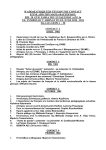
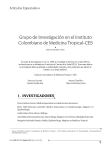
![Expanding Grain Model [EGM v1.0] - Illinois Institute of Technology](http://vs1.manualzilla.com/store/data/005895685_1-bff858b86f7bc344864531d7e5f7cd87-150x150.png)
